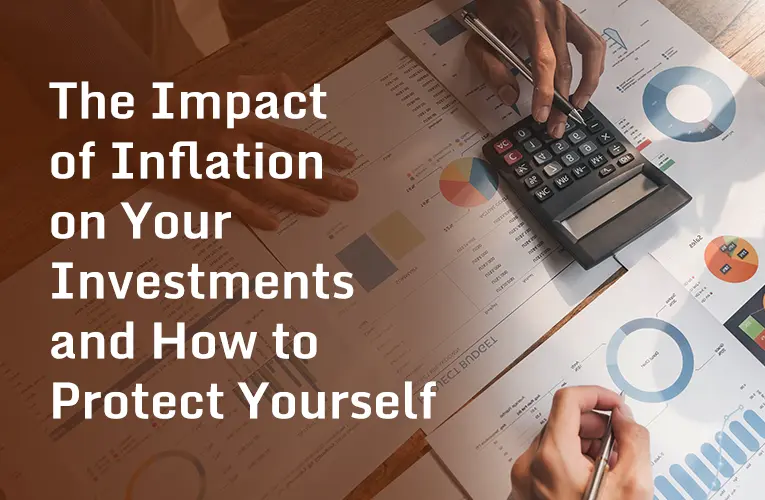## The Impact of Inflation on Your Investments and How to Protect Yourself
### Understanding Inflation
**What is Inflation?**
Inflation refers to the rate at which the general level of prices for goods and services rises, leading to a decrease in the purchasing power of money. It is typically measured by indexes such as the Consumer Price Index (CPI) or the Producer Price Index (PPI). Inflation can be caused by various factors, including increased demand, supply chain disruptions, and monetary policy changes.
**Types of Inflation:**
1. **Demand-Pull Inflation:** Occurs when demand for goods and services exceeds supply, driving prices up.
2. **Cost-Push Inflation:** Results from an increase in production costs, such as wages or raw materials, which leads to higher prices for consumers.
3. **Built-In Inflation:** Arises from the adaptive expectations of businesses and workers, leading to wage and price increases over time.
### How Inflation Affects Investments
**1. Stocks and Equities**
**Impact of Inflation:**
Inflation can have a mixed effect on stocks and equities. On one hand, moderate inflation can be beneficial for companies as it often signals economic growth and increased consumer spending. On the other hand, high inflation can squeeze profit margins, lead to higher interest rates, and create economic uncertainty, which can negatively affect stock prices.
**Protective Strategies:**
– **Invest in Dividend Stocks:** Companies that pay dividends can provide a steady income stream that may outpace inflation.
– **Focus on Sectors that Benefit from Inflation:** Energy, materials, and consumer staples companies often perform well during inflationary periods.
**2. Bonds and Fixed-Income Securities**
**Impact of Inflation:**
Bonds and fixed-income securities are particularly vulnerable to inflation. As inflation rises, the fixed interest payments from bonds become less valuable in real terms. Additionally, central banks may raise interest rates to combat inflation, which can lead to a decline in bond prices.
**Protective Strategies:**
– **Consider Inflation-Protected Securities:** Treasury Inflation-Protected Securities (TIPS) are designed to protect against inflation as their principal value increases with inflation.
– **Shorten Duration:** Shorter-duration bonds are less sensitive to interest rate changes and can help mitigate inflation risk.
**3. Real Estate**
**Impact of Inflation:**
Real estate is generally considered a good hedge against inflation. As prices rise, the value of real estate properties typically increases, and rental income often rises with inflation, providing a potential buffer against the eroding effects of inflation on your purchasing power.
**Protective Strategies:**
– **Invest in Rental Properties:** Rental income can increase with inflation, providing a steady income stream.
– **Diversify Across Property Types:** Consider diversifying your real estate investments to include residential, commercial, and industrial properties.
**4. Commodities and Precious Metals**
**Impact of Inflation:**
Commodities and precious metals, such as gold and silver, are traditional hedges against inflation. Their prices often rise when inflation accelerates, as they are tangible assets that hold intrinsic value.
**Protective Strategies:**
– **Allocate to Commodity Funds:** Investing in commodity-focused mutual funds or ETFs can provide exposure to various assets that typically perform well during inflationary periods.
– **Consider Precious Metals:** Gold and silver can act as a store of value and a hedge against inflation.
**5. Cash and Cash Equivalents**
**Impact of Inflation:**
Cash and cash equivalents, such as savings accounts and money market funds, are the most directly impacted by inflation. As inflation rises, the real value of cash holdings diminishes, reducing your purchasing power.
**Protective Strategies:**
– **Invest in Inflation-Protected Assets:** Use cash to invest in assets that have the potential to outpace inflation.
– **Maintain a Balanced Portfolio:** Avoid holding excessive amounts of cash and ensure your portfolio includes investments with inflation-hedging properties.
### Strategies to Protect Your Investments from Inflation
**1. Diversification**
**Why It Matters:**
Diversification involves spreading your investments across various asset classes to reduce risk. A well-diversified portfolio can help mitigate the impact of inflation on any single investment.
**How to Implement:**
– **Allocate Across Asset Classes:** Invest in a mix of stocks, bonds, real estate, and commodities.
– **Diversify Within Asset Classes:** For example, within stocks, include both growth and value stocks, and across different sectors.
**2. Real Assets**
**Why They Matter:**
Real assets, such as real estate and commodities, tend to hold their value better during inflationary periods. Investing in real assets can help preserve your wealth.
**How to Implement:**
– **Invest in Real Estate Investment Trusts (REITs):** REITs offer exposure to real estate without the need to own physical properties.
– **Invest in Commodities:** Allocate a portion of your portfolio to commodity-focused investments or commodity ETFs.
**3. Inflation-Protected Securities**
**Why They Matter:**
Inflation-protected securities, such as TIPS, are designed to adjust their value with inflation, ensuring that your investment maintains its purchasing power.
**How to Implement:**
– **Purchase TIPS Directly:** Buy TIPS through the U.S. Treasury or through mutual funds and ETFs that focus on inflation-protected securities.
– **Include in Retirement Accounts:** Consider holding TIPS in tax-advantaged accounts like IRAs or 401(k)s to benefit from their inflation-protection features.
**4. Adjust Asset Allocation**
**Why It Matters:**
Adjusting your asset allocation in response to changing economic conditions can help protect your portfolio from the negative effects of inflation.
**How to Implement:**
– **Increase Allocation to Inflation-Hedging Assets:** Consider increasing your investments in real estate, commodities, and inflation-protected securities.
– **Rebalance Regularly:** Regularly review and adjust your asset allocation to ensure it aligns with your investment goals and inflation expectations.
**5. Focus on Growth Investments**
**Why They Matter:**
Growth investments, such as stocks in high-growth sectors, have the potential to outperform during inflationary periods by benefiting from rising prices and increased demand.
**How to Implement:**
– **Invest in Growth Stocks:** Focus on companies with strong earnings growth potential and pricing power.
– **Consider Technology and Innovation:** Sectors such as technology and healthcare often have strong growth prospects and can perform well during inflationary periods.
### Case Studies
**1. Historical Perspective:**
During the 1970s, the U.S. experienced high inflation, known as stagflation. Investors who held real assets, such as gold and real estate, generally fared better compared to those heavily invested in bonds and cash. This historical example underscores the importance of including inflation-hedging assets in your portfolio.
**2. Modern Examples:**
In recent years, investors have faced varying levels of inflation due to economic events such as the COVID-19 pandemic. Those who adjusted their portfolios by including inflation-protected securities and real assets generally found better protection against inflation’s adverse effects.
### Conclusion
Inflation is a significant economic factor that can impact various types of investments and erode your purchasing power. Understanding how inflation affects your investments and implementing strategies to protect yourself is crucial for maintaining and growing your wealth. By diversifying your portfolio, investing in real assets, focusing on inflation-protected securities, and adjusting your asset allocation, you can safeguard your financial future against the adverse effects of inflation.
### SEO Keywords
1. **Impact of Inflation on Investments**
2. **How Inflation Affects Stocks and Bonds**
3. **Protecting Investments from Inflation**
4. **Inflation-Protected Securities**
5. **Investment Strategies for Inflation**
6. **Real Assets as Inflation Hedges**
7. **Inflation and Investment Portfolio Management**
8. **Best Investments During Inflation**
9. **Understanding Inflation and Financial Planning**
10. **How to Hedge Against Inflation in Your Investments**
By incorporating these keywords strategically throughout your article, you can enhance its visibility and relevance in search engine results, attracting readers interested in protecting their investments from inflation.










